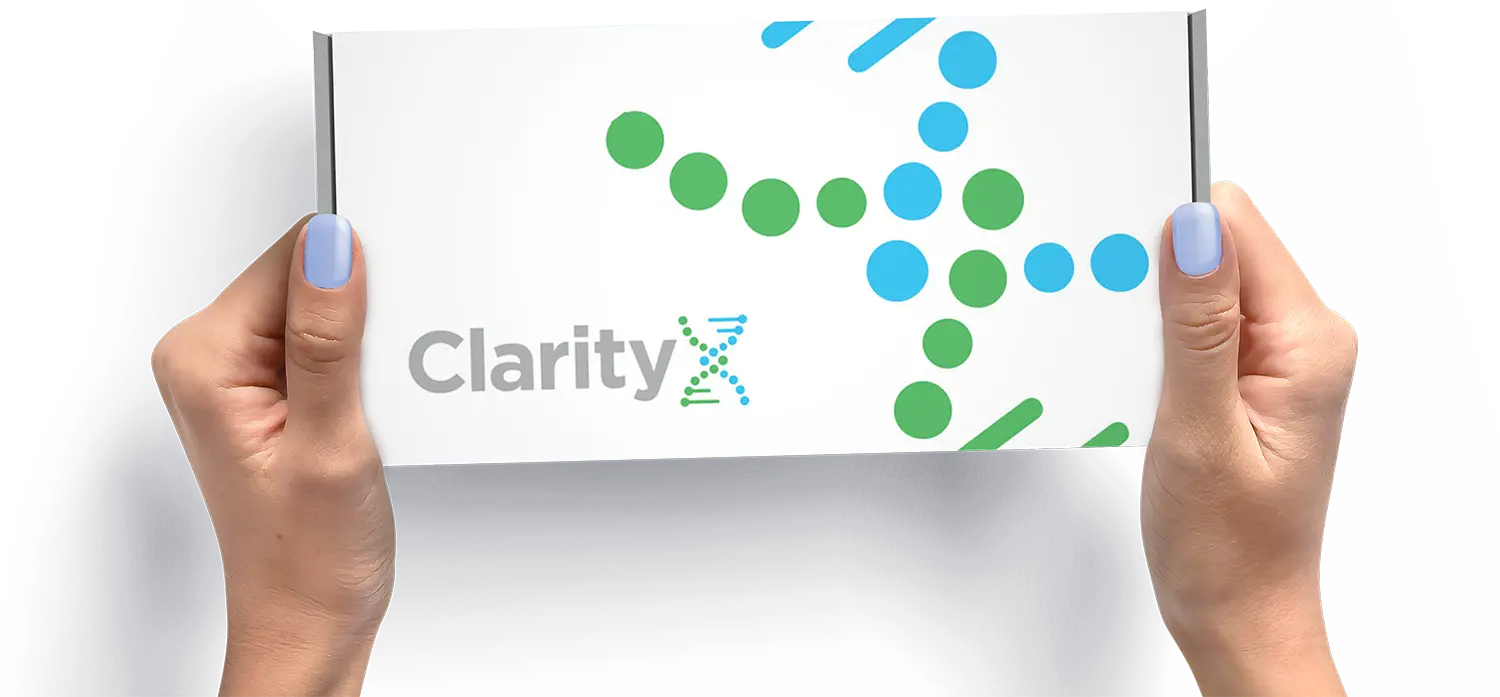Learn about the differences between Paxil and Prozac and how to choose the right antidepressant treatment.
Paxil® (paroxetine) vs. Prozac® (fluoxetine)
Conflicts, work obligations, and daily stresses can take a toll on our mental health, leading to problems like depression and anxiety. If you struggle with mental wellness, it's important to seek treatment, otherwise, the issue can worsen over time.
One of the most popular treatments for mental health conditions is antidepressants. In this article, we will compare two commonly prescribed antidepressants: Prozac (fluoxetine) and Paxil (paroxetine). Read on to learn more about their indications, strengths, formulations, side effects, drug metabolism, and how pharmacogenomic (PGx) testing from ClarityX can help you and your provider choose the right medication.
Introduction
Paxil and Prozac function similarly and both are in a class of antidepressants called selective serotonin reuptake inhibitors (SSRIs). Increasing serotonin levels in the brain can improve symptoms of depression such as appetite, sleep issues, and loss of interest. SSRIs are frequently used antidepressants due to their effectiveness, tolerability, and low likelihood of overdosing and are commonly used to treat mental health conditions like major depressive disorder, generalized anxiety disorder, obsessive-compulsive disorder, and post-traumatic stress disorder. 1
Major depressive disorder (MDD) is a mood disorder associated with consistent, overwhelming sadness and melancholy. If an individual experiences a major depressive episode lasting at least two weeks with five or more of the following symptoms a person is thought to be suffering from MDD: depressed mood, loss of interest, trouble sleeping or sleeping too much, changes in appetite or weight, low energy, poor concentration, thoughts of worthlessness or guilt, and thoughts of suicide.2
During the depression, the brain produces fewer neurotransmitters. By increasing neurotransmitters like serotonin through the use of Paxil and Prozac, they can restore these chemical imbalances in the brain and consequently reduce symptoms of depression. However, Prozac and Paxil are not just used for the treatment of MDD. Let’s take a look at the other labeled indications and off-label uses for Prozac and Paxil in the following chart.
| Labeled Indications | Off-Label Uses | |
| Fluoxetine (Prozac) | Bipolar major depression; Bulimia nervosa; Major depressive disorder; Obsessive-compulsive disorder; Panic disorder; Premenstrual dysphoric disorder, Treatment-resistant depression | Binge eating disorder; Body dysmorphic disorder; Fibromyalgia, refractory; Generalized anxiety disorder; Posttraumatic stress disorder; Premature ejaculation; Selective mutism; Social anxiety disorder |
| Paxil (Paroxetine) | Generalized anxiety disorder; Major depressive disorder; Obsessive-compulsive disorder; Panic disorder; Posttraumatic stress disorder; Premenstrual dysphoric disorder; Social anxiety disorder, Vasomotor symptoms of menopause | Body dysmorphic disorder; Premature ejaculation |
3 4
Paxil vs Prozac: Dosage Amounts
Since Paxil (paroxetine) and Prozac (fluoxetine) are both SSRIs, it's common to assume they are interchangeable treatment options. In reality, these drugs have different dosage requirements that would make it more complicated to just interchange them.
The chart below illustrates how Prozac and Paxil differ in terms of formulations and strengths available in the United States.
| Formulations | Strengths | |
| Prozac (fluoxetine) | -Capsule -Capsule (Delayed Release) -Solution -Tablet |
-10mg, 20mg, & 40mg -90mg -20mg/5ml -10mg, 20mg, & 60mg |
| Paxil (Paroxetine) | -Capsule -Capsule (Extended Release) -Suspension -Tablet |
-7.5mg -12.5mg, 25mg, & 37.5mg -10mg/5ml -10mg, 20mg, 30mg, & 40mg |
5 6
Paxil vs. Prozac: Side Effects
One of the most important factors to consider during drug selection is side effects. Both Paxil and Prozac may cause the following:
- Fatigue and lack of energy
- Decreased libido/sexual side effects
- Dry mouth and nausea
- Constipation and diarrhea
- Lower appetite and weight changes
Both drugs also have their own side effects. For instance, some Paxil users experience muscle pain (which is rare when taking Prozac). On the flip side, Prozac is more likely to cause insomnia (due to its stimulating effects).
There are several reasons why one might be at a higher risk of experiencing side effects, such as age, environment, and lifestyle habits. In addition, a person’s genetics can influence a person’s likelihood of experiencing side effects. Let's take a closer look at how genetics can impact Prozac and Paxil.
Prozac vs Paxil Drug Metabolism
Of course, every patient has their own experience with medications. Some may experience many side effects, while others respond without any issues. Many times, drugs are directly impacted by enzymes (CYP450 enzymes) that are responsible for eliminating or activating them in the body. An individual’s genetics can affect the CYP450 enzyme’s ability to metabolize drugs. Let’s take a look at some examples of how this can affect Prozac and Paxil in the body.
Prozac (fluoxetine) is primarily metabolized by CYP2C19 and CYP2D6. However, CYP2D6 is its major metabolizing contributor in the body. Prozac is unique in that generally it is not affected by genetic variations of the enzyme CYP2D6. However, Prozac can inhibit CYP2D6 from breaking down other medications in the body. For example, when combining Prozac with other medications metabolized by CYP2D6 (tricyclic antidepressants, antipsychotics, and antiarrhythmics), can affect how those medications are eliminated from the body. Therefore, this can produce unwanted side effects with those combinations of medicines with Prozac. 7
Paxil (paroxetine) is primarily metabolized by CYP2D6. It is recommended that when someone’s PGx report indicates that they have a poor metabolizing function of the CYP2D6 enzyme that it should not be taken due to the risk of Paxil building up in the body and causing side effects. However, if Paxil does need to be used in this situation at least a 50% initial dose reduction is recommended when starting Paxil.8
ClarityX Pharmacogenomic (PGx) Testing
Currently, the way mental health providers distinguish between prescribing Prozac or Paxil is to initiate one of the drugs, then wait to see the results. If it proved ineffective, the mental health provider might choose to increase the dosage. If it caused severe side effects, they might decrease the dosage or switch to another drug.
Pharmacogenomic (PGx) testing lets you skip this time-consuming trial and error process by immediately identifying which drug can work better for you based on your unique genetics. Not only will it help you decide between medications, but it can also help with selecting the optimal dosages.
So, how exactly does a PGx test work? It starts by analyzing the genetic material available in your DNA. More specifically, it examines the genetic variations in enzymes in the body that metabolize (eliminate or activate) drugs. If your test results reveal that you break down certain drugs too slowly (poor metabolizer) or quickly (ultra-rapid metabolizer), your healthcare provider will be better informed on how to adjust your medications or simply avoid them.
ClarityX has a unique mental health PGx test called Mindwell that can help provide information on treatments designed for mental health conditions, including antidepressants, antipsychotics, and anxiolytics. The Mindwell Test provides a seamless in-home testing experience. Simply visit the website clarityxdna.com, select the Mindwell test option from the drop-down menu, and complete the checkout process. Once the kit is received follow the package instructions, perform a simple cheek swab, then mail the sample back using the prepaid envelope. The sample is then sent to the lab for processing and the results are received by the patient or provider in 7-14 days on average.
One of the most important facts about pharmacogenetic (PGx) testing is the results can be reevaluated for future medication changes as this test does not have to be repeated for those specific genes tested. Another key function of the Mindwell test is that over 130 specific medications can be entered to be evaluated to see how an individual’s genetic make-up can affect those drugs. Pharmacogenetic (PGx) testing can provide a lifetime of knowledgeable decisions about medication selection for health care teams.
When trial and error isn’t practical or simply too time-consuming and inconvenient, pharmacogenetic (PGx) testing for mental health medications can help providers prescribe proper dosages and determine which drugs will have the most benefit or potentially cause the most side effects. Having the proper mental health medication along with its appropriate dosage can have a huge impact on those with mental illnesses. It’s well documented that antidepressants can take up to four to six weeks before they provide any relief to mental health conditions like depression. More often than not patients will stop taking antidepressants usually within a few months because of negative side effects or the medication wasn’t working at all to resolve their symptoms. Patient’s abruptly stopping their mental health medications can produce other problems on top of their current mental health diagnosis such as withdrawal symptoms. Many of these complications can be avoided by simply having knowledge of how a patient uniquely reacts to mental health medications.
Citations
1 Selective serotonin reuptake inhibitors: Pharmacology, administration, and side effects. UpToDate. (n.d.). Retrieved June 6, 2022, from https://www.uptodate.com/contents/selective-serotonin-reuptake-inhibitors-pharmacology-administration-and-side-effects#H399779781
2 Unipolar major depression in adults: Choosing initial treatment. UpToDate. (n.d.). Retrieved June 6, 2022, from https://www.uptodate.com/contents/unipolar-major-depression-in-adults-choosing-initial-treatment?search=major+depressive+disorder&source=search_result&selectedTitle=1~150&usage_type=default&display_rank=1#H21696450
3 Fluoxetine Drug Information. UpToDate. (n.d.). Retrieved June 6, 2022, from https://www.uptodate.com/contents/fluoxetine-drug-information?topicRef=14675&source=see_link#F54703991
4 Paroxetine: Drug information. UpToDate. (n.d.). Retrieved June 6, 2022, from https://www.uptodate.com/contents/paroxetine-drug-information?source=auto_suggest&selectedTitle=1~1---1~4---paxil&search=paxil#F206570
5 Fluoxetine Drug Information. UpToDate. (n.d.). Retrieved June 6, 2022, from https://www.uptodate.com/contents/fluoxetine-drug-information?topicRef=14675&source=see_link#F54703991
6 Paroxetine: Drug information. UpToDate. (n.d.). Retrieved June 6, 2022, from https://www.uptodate.com/contents/paroxetine-drug-information?source=auto_suggest&selectedTitle=1~1---1~4---paxil&search=paxil#F206570
7 Annotation of FDA Label for fluoxetine / olanzapine and CYP2D6. PharmGKB. (n.d.). Retrieved June 6, 2022, from https://www.pharmgkb.org/labelAnnotation/PA166104788
8 Annotation of CPIC Guideline for paroxetine and CYP2D6. PharmGKB. (n.d.). Retrieved June 6, 2022, from https://www.pharmgkb.org/chemical/PA450801/guidelineAnnotation/PA166127636





